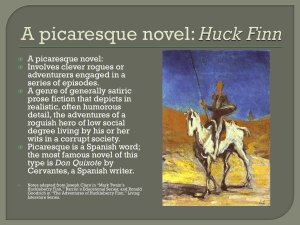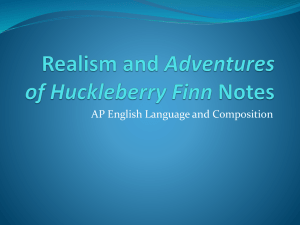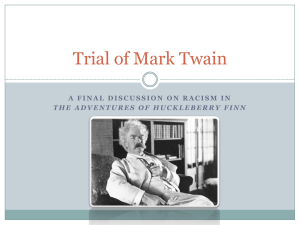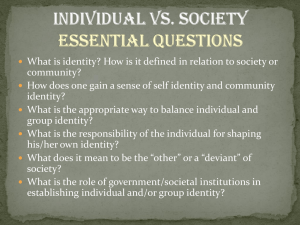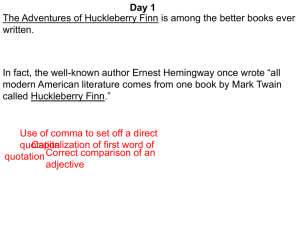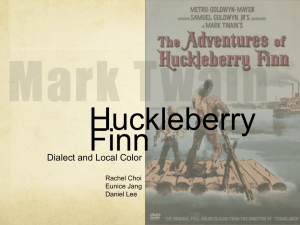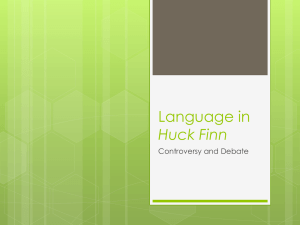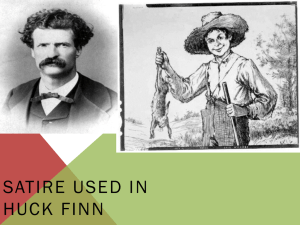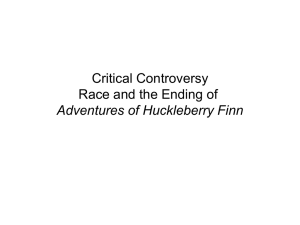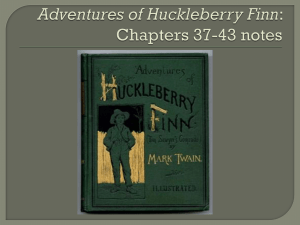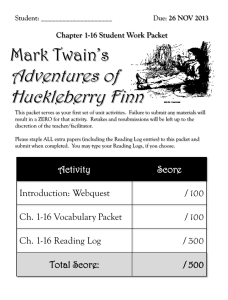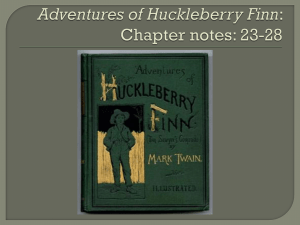Huckleberry Finn PowerPoint
advertisement
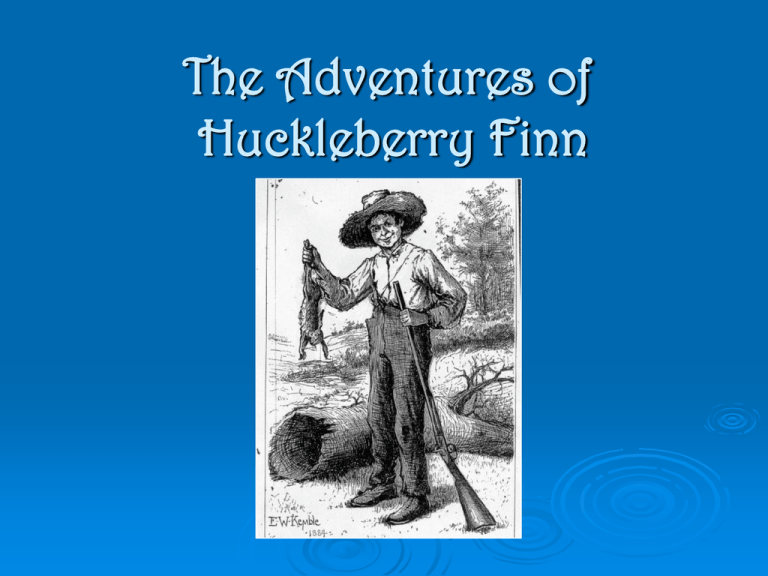
The Adventures of Huckleberry Finn By Mark Twain Real name was Samuel Langhorne Clemens Born November 30,1835, the night Halley’s Comet flashed across the sky Halley’s comet is the only comet visible to the naked eye Appears about every 75 years Grew up along the Mississippi River Quit school at age 12 Died on April 21, 1910, as Halley’s comet again flashed through the sky TWAIN’S WORKS Travel books (non-fiction) Innocents Abroad Life on the Mississippi Historic novels The Prince and the Pauper A Connecticut Yankee in King Arthur´s Court Short stories The Celebrated Jumping Frog of Calaveras Country The Novel The Adventures of Huckleberry Finn was written after The Adventures of Tom Sawyer. At the end of Tom Sawyer, Huckleberry Finn, a poor boy with a drunken father, and his friend Tom Sawyer, a middleclass boy with an imagination too active for his own good, found a robber's stash of gold. As a result of his adventure, Huck gained quite a bit of money, which the bank held for him in trust. Huck was taken in by the Widow Douglas, a kind but stifling woman who lives with her sister, the self-righteous Miss Watson. Introduction Mark Twain described the major theme of The Adventures of Huckleberry Finn as “A sound heart and a deformed conscience come into collision, and conscience suffers defeat.” •“A sound heart” = a good, honest heart. •“A deformed conscience” = a conscience influenced by the laws of society and a sense of duty toward those laws. Key Facts Genre Satiric Novel (Fiction) • A work that uses humor, irony, and extreme exaggeration to ridicule society in order to bring about change Narrator & Protagonist Huck Finn: literal, realistic, practical Setting Time • Before the Civil War; roughly 1835–1845 Place • The Mississippi River town of St. Petersburg, Missouri • The adventure continues down the Mississippi into Arkansas Themes: What does Twain teach us about each idea? Racism & Slavery Intellectual and Moral Education The Hypocrisy of “Civilized” Society Racism & Slavery Although written 20 years after the Emancipation Proclamation, America – especially the South – was still struggling with racism and the aftereffects of slavery. Insidious racism arose near the end of Reconstruction that oppressed blacks for illogical and hypocritical reasons. Twain exposes the hypocrisy of slavery and demonstrates how racism distorts the oppressors as much as the oppressed. The result is a world of moral confusion. Intellectual and Moral Education Huck is an uneducated boy. He distrusts the morals and precepts of the society that treats him as an outcast and fails to protect him from abuse. Huck questions his teachings, especially regarding race and slavery. In many instances, Huck chooses to “go to hell” rather than go along with the rules of society. The Hypocrisy of “Civilized” Society “Civilized” to Huck means . . . Regular baths, uncomfortable clothes Mandatory school attendance Degraded rules that defy logic • Huck’s drunkard, abusive father gets to keep custody of Huck because he is his natural father • The injustice of slavery that keeps Jim from his family • Seemingly good people are prejudiced slaveowners • Terrible acts go unpunished, while lesser crimes lead to severe punishment Motifs Motifs are recurring structures, contrasts, or literary devices that can help to develop and inform the text’s major themes. Childhood • Huck’s youth is an important factor in his moral education; only a child is open-minded enough to undergo the kind of development that Huck does. Lies and Cons • Huckleberry Finn is full of malicious lies and scams; the lies are bad and hurt a number of innocent people. Superstitions and Folk Beliefs • Jim believes in a wide range of superstitions and folktales; although Huck is reluctant to believe at first, many of the beliefs indeed have some basis in reality. Parodies of Popular Romance Novels • The story is full of people who base their lives on romantic literary models and stereotypes of various kinds Tom Sawyer, for example, bases his life and actions on adventure novels Conflict and Climax Major Conflict: Huck’s internal struggle with his “deformed conscience.” Climax: The point in the story where the protagonist’s conflict is resolved, leading to the resolution of the story. The climax of Huckleberry Finn is when Huck decides to steal Jim out of slavery from the Phelps farm (his own moral code) despite the fact that he believes he will suffer in hell for it (society’s teachings) Quotes Dat truck dah is trash; en trash is what people is dat puts dirt on de head er dey fren’s en makes ‘em ashamed. It don’t make no difference how foolish it is, it’s the right way – and it’s the regular way. All right then, I’ll go to hell. You feel mighty free and easy and comfortable on a raft. People would call me a low doen Ablitionist and despise me for keeping mum – but that don’t make no difference. I ain’t going to tell. I do believe he cared just as much for his people as white folks does for their’n. It don’t seem natural, but I reckon it’s so. What! And not sell out the rest o’ the property? Human being can be awful cruel to one another. It was enough to make a body ashamed of the human race. Major Symbol: The Mississippi River In Huck Finn, the river symbolizes freedom, and it becomes symbolic of Huck’s journey to discover his natural virtue. The current determines the direction of the raft as well as Huck’s life. There is a major contrast between life on the river and life on the shore because life on the river (uncivilized) is peaceful and easy, yet not totally without danger; however, life on the shore (civilized) can be cruel, authoritarian, hypocritical, and reflective of what Twain called the “Damned Human Race.” Life on the raft is paradoxical. Even though they are confined to a small space on the raft, Huck and Jim experience greater freedom on the raft. Critics’ Comments The Adventures of Huckleberry Finn has been a controversial book since it was first published in 1885 – mostly because of its inappropriate language and racial slurs. The following slides will represent four different points of views of Twain’s most famous novel. 1884 Written by William E. Henley of the Athenaeum “In Huckleberry Finn Twain returns to his right mind” “The book is Mark Twain at his best” “It is meant for boys” “Huckleberry . . . is the hero of such scrapes and experiences as to make your mouth water” “Jim and Huckleberry are real creations” 1885 Statements made by the Concord Library Committee after they excluded the book for the public library “absolutely immoral in its tone” “very little humor” “If not for the author’s reputation, the book would undoubtedly meet with severe criticism.” “the veriest trash” “a low grade of morality” “language of a rough, ignorant dialect” “systematic use of bad grammar and an employment of rough, inelegant expressions.” 1992 Comments by John H. Wallace of The Washington Post “Huckleberry Finn uses the pejorative [insulting] term nigger profusely.” “It speaks of black Americans with implications that they are not honest, they are not intelligent as whites, and they are not human.” “It constitutes mental cruelty, harassment, and outright racial intimidation to force black students to sit in a classroom to read this kind of literature . . .” 1992 Written by Clarence Page of the Des Moines Register “Huckleberry Finn may have been black . . . No, not Huck himself, but his voice.” “The news that ol’ Huck might have been a soul brother is ironic considering how many blacks have tried to keep Huckleberry Finn out of the hands of school children every year, despite its strong antislavery, pro-brotherhood message, because it happens to mention the word ‘nigger’ about 200 times. “Twain exposed the lunacy and hypocrisy of American racism by showing it through the eyes of a boy who finds himself . . . helping a slave to escape.” “I , too, flinched when I heard my white teacher reading the word ‘nigger’ aloud when she introduced our ninth grade class to the book. But I soon found myself reading it on my own, at first out of curiosity, then out of sheer pleasure.” Twain’s View on Slavery As a schoolboy, Twain had no aversion to slavery He was not aware there was anything wrong with it The papers said nothing against it Churches taught that God approved it He took a strong liking to blacks when they worked on his family’s farm He and his family were friends with many blacks in his home town of Hannibal Twain’s family owned a slave that he deeply admired Twain called him “Uncle Dan’l” The character of Jim in Huck Finn is said to be modeled after this man He is also mentioned in several other Twain stories under his real name
